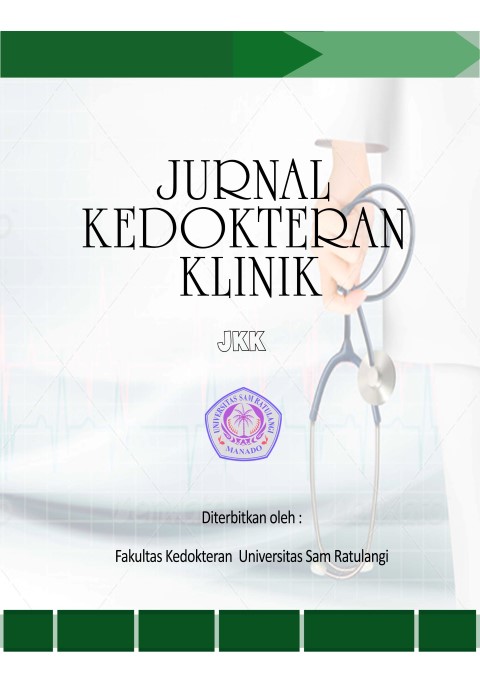Perbandingan Kadar Besi dalam Darah antara Subyek Obesitas Prehipertensi dengan Subyek Obesitas Normotensi pada Mahasiswa FK UNSRAT
Keywords:
Iron level, Obesity, PrehypertensionAbstract
Abstract
Background : A growing number of young adult having a slight higher blood pressure were recently found, especially with obesity. Individual with prehypertension is profound to develop hypertension and in increased risk of having cardiovascular event compared to individual with normotension. Past studies showed that inflammation process was played a major role in individual with obesity. Pathogenesis of the inflammation in obesity was not clearly understood, but new studies shows indication of oxidative stress, which one of the source was iron. Method: This was a cross sectional study that include 38 medical faculty of samratulangi university student. Which 19 subjects had central obesity with normotension and 19 subjects had prehypertension (19 subject). Exclusion criteria were Anemia, Hypotension,Hypertension stage II, and acute infection. T test was done in measuring the ferittin levels between normotension and prehypertension in central obesity subject. Result:From 38 central obesity medical student that is included in this study. 19 were prehypertension and the rest was normotension. With mean iron levels in central obesity normotension subject was 141,15+ 66,994; and the mean iron level in prehypertension was 345,74+ 172.82 with P <0,001 Conclusion:There is a significance difference in mean iron level between obesity prehypertension subject and normotension obesity subject in medical faculty of samratulangi student.
Keyword: Iron level, Obesity, Prehypertension
Abstrak
LatarBelakang: Peningkatan ringan tekanan darah semakin sering ditemukan pada usia muda, terutama mereka dengan obesitas. Individu dengan Prehipertensi beresiko menjadi hipertensi dan lebih beresiko mengalami kejadian kardiovaskular dibandingkan dengan individu dengan normotensi. Penelitian terdahulu membuktikan bahwa terjadi proses inflamasi pada individu dengan obesitas. Patogenesis dari inflamasi yang terjadi pada obesitas belum sepenuhnya dimengerti, tetapi studi terbaru mengindikasikan adanya stres oksidatif, dimana salah satu sumbernya adalah zat besi. Metodologi : Penelitan ini merupakanpenelitianpotonglintangpada 38 mahasiswa FK UNSRAT yang mengalami obesitas sentral dengan normotensi (19 subyek) dan prehipertensi (19 subyek). Kriteria Eksklusi meliputi Anemia, Hipotensi, Hipertensi Stage II, dan infeksi akut. Dilakukan uji Beda Rerata antara kadar Feritin antara Normotensi dengan PreHipertensi pada Subyek Obesitas Sentral. Hasil: Dari 38 mahasiswa obesitas sentral yang ikut serta dalam penelitian ini, 19 diantaranya prehipertensi, dan sisanya normotensi.  Rerata kadar zat besi pada kelompok obesitas sentral normotensi adalah 141,15 + 66,994; sedangkan rerata kadar zat 345,74 + 172,82 dengannilai p<0,001 Kesimpulan: Terdapat perbedaan rerata kadar zat besi dalam darah antara Subyek Obesitas Prehipertensi dengan Subyek Obesitas Normotensi pada Mahasiswa FK UNSRAT.
Kata Kunci: ZatBesi, Obesitas, Prehipertensi
References
DAFTAR PUSTAKA
Abbaspur N, Hurrell R, Kelishadi R. Review on iron and its importance for human health. J Res Med Sci 2014; 19(2): 164–74.
Aisen P, Enns C, Wessling-Resnick M. Chemistry and biology of eukaryotic iron metabolism. Int J Biochem Cell Biol. 2001; 33: p940–59.
Ascherio A et al. Blood Donations and Risk of Coronary Heart Disease in Men. Circulation. 2001;103:52-57. Downloaded from http://circ.ahajournals.org/ by guest on July 13, 2016
Bacon B R, Adam P C, Kowdley K V, Powell L W, Tavill A S. Diagnosis and management of hemochromatosis :2011 practise guideline by the american association for the study of liver disease. Hepatology 2011;54(1):328-42.
Datta et al,Effect of Frequent Blood Donation on Iron Status of Blood Donors In Burdwan, West Bengal, India. Journal of Drug Delivery & Therapeutics; 2013, 3(6), 66-69. Available online at http://jddtonline.info
Frazer D M, Anderson G J. Intestinal iron absorbtion and regulation. Am J Physiol
Gastrointest Liver Physiol. 2005; 289; p631–5.
Ganz T. Hepcidin, a key regulator of iron metabolism and mediator of anemia of inflammation. Blood 2003;102(3):783-8
Hoffbrand AV, Catovsky D, Tuddenham EGD. Postgraduated Haematology. In:wordwood
M, Hoffbrand AV, editor. Iron Metabolism, Iron Deficiency andDisorders of Haem
Synthesis. 5th ed. London : Blackwell publishing; 2005. p. 26-40
McDowell L R. Mineral in animal and human nutrition 2nd edition. Amsterdam: Elsevier Science. 2003. p203–33.
Mitchell RN. Blood Vessels in Kumar V, Abbas AK, Aster JC (eds.). Robbins and Cotran’s Pathologic Basis of Disease 9th ed. Philadelphia: Elsevier. 2015.pp 491-501
Penggono MD. Polisitemia Vera. Dalam: Setiati S, Alwi I, Sudoyo AW, Simadibrata MK, Setiyohadi B,Syam AF (editor). Buku Ajar Ilmu Penyakit Dalam. Jakarta 2014; Edisi VI: hal. 2663-70.
Porter J B. Practical management of iron overload. Br J Haematol. 2001; 115: p239–52
Porter J B, Garbowski M. The patophysiology of transfusional iron overload. Hematol Oncol
Clin N Am. 2014; 28: 683–701.
Sugondo S. Obesitas. Dalam: Sudoyo A W, Setyohadi B, Alwi I, Simadibrata MK, Setiati S (editor). Buku Ajar Ilmu Penyakit Dalam. Jakarta 2014; Edisi VI:hal.2559-569.
Uche EI et al. Lipid profile of regular blood donors. J Blood Med. 2013; 4: 39– 42.
Wang J, Pantopoulos K. Regulation of cellular iron metabolism. Biochem J. 2011; 434: p365–81
Wirawan R. Pemeriksaan laboratorium hematologi. 1st Ed. Balai Penerbit FKUI. 2011

